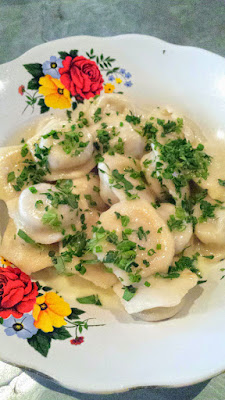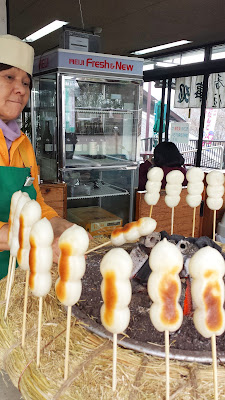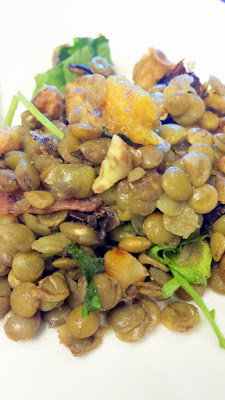My trip to Japan occurred during Christmas and New Year’s. For the Japanese, Christmas is not seen as a religious holiday, which makes sense since they don’t share the Christian religion, with Shinto and Buddhism dominating as the national religions instead. But, they have carried over one major thing – the idea of lots of sparkling holiday lights which they call Winter Illuminations.
In the Western world not all those that celebrate Christmas are religious either of course. Nowadays Christmas often leans more towards being a cultural holiday involving family gathering together. It’s also a consumerist holiday involving a lot of shopping and holiday sales in the name of gift giving and holiday parties.
But the Japanese don’t really celebrate Christmas in either of those ways either, with the only 2 exceptions being the pushing of Kentucky Fried Chicken as a Christmas meal, and the promotion of Christmas Cake. You can reserve your KFC meal ahead of time, and there are lines! I was somehow charmed by Colonel Sanders Santa every time I saw him though.


For the Japanese, instead it’s New Year’s that is the time for gathering with families – many people close down their shops or leave work for extended holidays to return to their hometowns. Similarly, it’s the rationale of New Year’s for their end of year holiday parties, and big New Year’s sale with heavily discounted grab bags.
As for presents, I won’t try to touch the explanation for gift giving in Japanese culture that has a whole etiquette involved in terms of presentation, social obligation, reciprocation, and the many many reasons and occasions that call for gift giving, including coming back from a trip or as thanks (or even as a thank you for a thank you…). For Christmas, only children who believe in Santa might receive gifts – Santa doesn’t give gifts to non-believers, which apparently includes all adults.


At least everyone gets to eat Christmas Cake, adults and kids
Instead, Christmas Eve and Day are regular work days. Some who might celebrate Christmas view it more as a romantic holiday where a couple goes out to celebrate on Christmas Eve. This explains why when I saw Christmas decorations, hearts sometimes showed up as a motif, and there were mostly couples not families who were out for Christmas.
Heart on Tokyo Tower as part of its Winter Fantasy ~ Orange Illumination from November 23 2015 to February 29 2016
The holiday lights are the most noticeable way that the Japanese celebrate Christmas. Most of the holiday lights I saw were in large public areas, often by a lot of stores, often in a park area and/or down entire streets. Though I don’t know if I can really call them Christmas lights, since some of those major light installations go up in early November. Although some of the lights might go down on December 25, others light installations might stay until even mid or end of February!
Christmas Trees are conceptual rather than any real evergreens or full of lots of ornaments.

Overall, there are several places that offer holiday lights where I often saw a lot of couples walking and enjoying it hand in hand (and of course snapping photos). During my trip, we made it to 3 Winter Illumination displays.
Shinjuku Terrace City Illumination
Shinjuku Terrace City is sort of an outdoor shopping space that has a small park between the stores. Within this park, they light up 300 globes and 235,000 LED bulbs on the trees.
These lights are up from mid November to mid February. So even if you are visiting not in the Christmas holiday time, you might be able to catch them!
It also included a “Christmas Tree” which is really more like a sculpture in the shape of a tree. The Penguin tree you saw earlier in this post was from this area. Also, there was another tree at the end of the park. Interestingly enough, it was all white and more of a tree shaped sculpture. It was illuminated with a projector that offered different patterns based on people putting hands on pedestal placed a bit in front of it. Each pattern was animated and used different colors, lasting for 30 seconds or so.
You can see there were apparently six different possible patterns on the sign to the left. To the right you can see a globe like pedestal with outlines of two hands that people would place their hands on to start a new projection/illumination on the tree.
Roppongi Hills
Roppongi Hills area has a “Christmas Tree” along with lights within a shopping center, and also all down the street of Keyakizaka. There are about 1,200,000 LEDs that switch from a “Snow and Blue” theme to “Candle and Red”. These lights were up from the beginning of November until Christmas Day, so given when you see Christmas stuff show up in stores here in the US, I could justify calling these holiday lights.
I liked the extra sparkle of the tree.

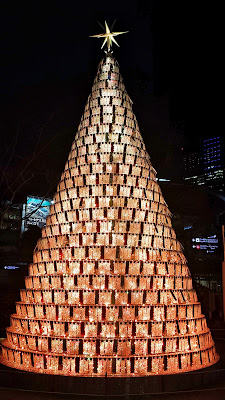
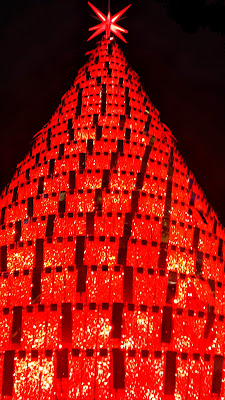
In the park area, the darker shady areas with the trees around the pond and which was quieter than the shopping area with the stores made for a romantic walk as couples held hands.
Roppongi Hills along Keyakizaka street is a fashionable area (reminds me a bit like Michigan Avenue) and we noticed a lot more women making up the population then usual who were dressed really well. The blue and white lights along the classy street were on every single tree. We were on our way to Midtown so didn’t linger long enough to see the change to the Candle and Red theme.
Midtown Christmas
Similarly, the Midtown Christmas, by the Galleria shopping center, has its display from mid November to December 25 also count as holiday lights to me. You can easily walk between Roppongi Hills to Midtown in order to see both these Winter Illuminations. The ones at Midtown include 180,003 lights and a “starry sky illumination” theme that include lights that appear to be shooting stars or falling stars, all set to music in a park in the back that they call a “Starlight Garden”.
It’s very organized even though it’s extremely popular – there is only one way to enter the park and then you walk counter clockwise, with cones and security there to maintain order. Here’s a look at the Starlight Garden from a balcony to get an idea of the size!
The lights – the way they slowly turn on just the blue at the time, and then adding more, the way they move with the music slowly downward while twinkling, upward like shooting into the sky, or fast horizontally on a circular track like a shooting star… it was breathtaking.
The beautiful Midtown Christmas Lights 2015 with 180,003 lights and a starry sky illumination technology light show set to music – in the background from this view you can see Tokyo Tower and its updated lighting that changes over time during the evening
These photos just don’t do it justice. So here’s a video we took, though that still doesn’t do justice to how it looked in person.
This is where I found a listing of the Winter Illuminations:
- Japan Guide’s list of Winter Illuminations covers the largest most famous ones in Japan
- Tokyo Cheapo ranked the Top 10 Winter Illuminations inside Tokyo
- GoTokyo also has a list of Tokyo’s Illumination Displays that includes some not listed by Tokyo Cheapo
- Tokyo Illuminations 15-16 from Time Out Tokyo
What do you think of how the Japanese celebrate Christmas? Is there anything you’d miss, or something you like about their view on Christmas? Have you been in a foreign country during Christmas before and how did they celebrate it that was different?
If you’re one of my Portland readers, and do you know there is a FREE Winter Light Festival for us too? Check out the family friendly Portland Winter Light Festival coming February 3-6, 2016 along the East Bank Esplanade and by OMSI.
Here’s a summary of my Japan Travel post series:
- Guide to Planning a Trip: Research
- Guide to Planning a Trip: Mapping
- Hagoita Ichi Winter Festival at Sensoji Temple, Japan
- Japanese Treats at Temples and Shrines
- Winter Illuminations in Tokyo (Winter Season – November – February!)
- Snow Monkeys in Hot Springs
- Onsen by Mount Fuji covers Onsen 101 and how we loved our stay at Lake Kawaguchiko
- Dining at a Ryokan a look at what a traditional dinner and breakfast might be during a ryokan stay
- Visiting Cup Noodles Museum in Yokohama (just outside Tokyo)
- Visiting Shin Yokohama Ramen Museum
- Kyoto Temples and Shrines (walking tour starting in Higashimaya with stops especially at Kiyomizudera Temple, Kodaji Temple, Heian Shrine)
- Kyoto Temples in Arashiyama
- Kyoto Tofu
- Kyoto Famous Sights of the Kinkakuji (The Golden Pavilion) and Fushimi Inari (Red Torii Gates)
- Famous Signs of Osaka and eating Osaka Food specialities like okonomiyaki, takoyaki and kushikatsu
- Visiting Himeji Castle, the famous white castle in Japan
- Fun at Japanese Cafes and More including Maid Cafe, Cat Cafe; theme parks of J World and Namja Town, a geeky stop at Kanda Myojin, and Ghibli Museum
- Japan Eating Checklist is my top 25 list of things to try to include as an eating experience when visiting Japan
- New Year’s in Japan: Oji Fox Parade, and some photos of a Meiji Shrine visit on New Year’s Day






